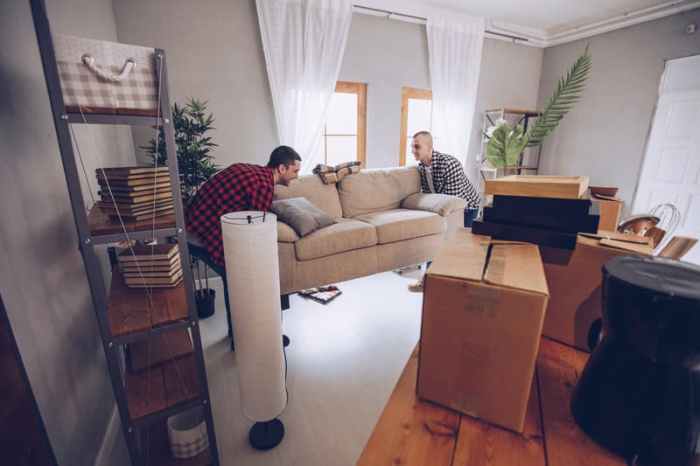Moving furniture to another state doesn’t have to break the bank. In this comprehensive guide, we’ll explore the cheapest way to move furniture to another state, covering everything from budget planning and moving methods to packing techniques and insurance options.
Whether you’re a seasoned mover or a first-timer, this guide will help you save money and ensure your furniture arrives safely at its new destination.
From negotiating with moving companies to renting a truck and packing your belongings like a pro, we’ll provide you with all the tips and tricks you need to make your move as smooth and affordable as possible.
Budget Planning

Moving furniture across state lines can be a significant expense, but there are ways to reduce costs without sacrificing quality. Here’s a detailed breakdown of expenses and strategies for saving money.
The primary expenses associated with moving furniture include:
- Moving company:Hiring a professional moving company is often the most convenient but also the most expensive option. Costs vary depending on the distance, weight of furniture, and level of service.
- Truck rental:Renting a truck is a more affordable option if you’re willing to do the heavy lifting yourself. Truck rental costs vary depending on the size of the truck and the rental period.
- Packing materials:Boxes, tape, bubble wrap, and other packing materials can add up quickly. Consider purchasing used materials or asking friends and family for help.
- Labor:If you’re not moving yourself, you’ll need to hire movers to load and unload the truck. Labor costs vary depending on the number of movers and the amount of furniture.
Strategies for Reducing Costs
Here are some strategies for reducing the cost of moving furniture across state lines:
- Negotiate with moving companies:Get quotes from multiple moving companies and negotiate the price. Be prepared to ask for discounts for off-season moves or if you’re flexible with the moving dates.
- Rent a truck:If you’re willing to do the heavy lifting yourself, renting a truck is a more affordable option. Be sure to factor in the cost of gas, insurance, and tolls.
- Pack yourself:Save money on labor costs by packing your furniture yourself. Use sturdy boxes and plenty of packing materials to protect your belongings.
- Ask for help:Friends and family can be a great source of free labor. Ask for help with packing, loading, and unloading the truck.
Moving Methods
Choosing the right method for moving your furniture to another state is crucial for a smooth and cost-effective relocation. Let’s explore the pros and cons of hiring professional movers versus renting a truck and moving yourself, along with the different types of moving trucks available and how to choose the right size.
Hiring Professional Movers
Pros:
- Convenience:Movers handle all aspects of the move, from packing to loading and unloading, saving you time and effort.
- Safety:Experienced movers know how to handle heavy and fragile items safely, reducing the risk of damage.
- Insurance:Reputable movers offer insurance to protect your belongings in case of any unforeseen events.
Cons:
- Cost:Hiring professional movers is typically more expensive than moving yourself.
- Scheduling:Movers’ schedules can be limited, so you may have to adjust your moving date to accommodate their availability.
Renting a Truck and Moving Yourself
Pros:
- Cost-effective:Renting a truck is significantly cheaper than hiring movers.
- Flexibility:You have complete control over the moving process and can move on your own schedule.
- Personal touch:You can pack and load your belongings exactly how you want them.
Cons:
- Physical effort:Moving heavy furniture and boxes requires a lot of physical effort.
- Time-consuming:Packing, loading, driving, and unloading can take a considerable amount of time.
- Risk of damage:If not handled properly, furniture and belongings can be damaged during the move.
Choosing the Right Moving Truck
If you decide to rent a truck and move yourself, it’s essential to choose the right size truck for your needs.
- Small trucks:Suitable for small apartments or a few rooms of furniture.
- Medium trucks:Ideal for moving a 2-3 bedroom house or a large apartment.
- Large trucks:Best for moving a 4+ bedroom house or a large office.
Consider the amount of furniture, boxes, and appliances you have, as well as the distance of the move, when selecting the appropriate truck size.
Packing and Loading Techniques

Proper packing and loading techniques are crucial for ensuring the safe transportation of your furniture during a long-distance move. By following these tips, you can minimize the risk of damage and ensure your belongings arrive at their destination in pristine condition.
Packing Techniques
To effectively pack furniture for moving, it is important to use sturdy boxes and plenty of cushioning materials, such as bubble wrap, packing paper, or foam peanuts. Disassemble furniture whenever possible to reduce its size and make it easier to pack.
Wrap each piece of furniture individually, paying special attention to corners and edges. Use shrink wrap or packing tape to secure the wrapping and prevent it from coming loose during transit.
When considering the cheapest way to move furniture to another state, exploring furniture rental companies like povison furniture can be a cost-effective option. They offer affordable furniture rental packages that eliminate the hassle and expenses associated with moving your own furniture.
By opting for rental furniture, you can save money on transportation, packing materials, and labor, making it a practical and budget-friendly solution for moving furniture across state lines.
Loading Techniques
When loading furniture into the moving truck, it is important to maximize space and ensure stability. Load heavy items first, placing them towards the front of the truck. Use furniture pads or blankets to protect the furniture from scratches and dents.
Secure all items with straps or ropes to prevent them from shifting during transit. Leave some space between furniture pieces to allow for air circulation and prevent moisture buildup.
Distance and Timing: Cheapest Way To Move Furniture To Another State
The distance between your current and new locations plays a significant role in determining moving costs and timelines. Longer distances require more transportation time, fuel consumption, and potentially additional overnight stops for the moving crew.
To optimize your move, consider the following:
Planning the Move
- Avoid Peak Moving Seasons:The summer months (May to September) are typically the busiest time for movers, leading to higher rates and limited availability. Consider scheduling your move during off-peak seasons (October to April) for more competitive pricing.
- Book Early:Securing a moving company well in advance (at least 2-3 months) allows you to secure the best rates and ensure availability on your preferred dates.
- Consider Flexible Dates:If possible, be flexible with your moving dates. Moving on weekdays or during the middle of the month often offers lower rates compared to weekends or month-ends.
DIY vs. Professional Movers
When relocating to another state, you’ll face the decision of whether to hire professional movers or tackle the move yourself. Both options have advantages and drawbacks, so it’s crucial to weigh the pros and cons before making a choice.
DIY Moving
Advantages:
-
-*Cost-effective
One of the cheapest ways to move furniture to another state is to rent a truck and drive it yourself. However, if you’re not comfortable driving a large truck, you can hire a professional moving company. If you do hire a moving company, be sure to ask if they offer tipping.
Do we tip furniture delivery ? The answer is yes, it is customary to tip furniture delivery drivers. The standard tip is 10-15%, but you can give more if you’re happy with the service. When you’re budgeting for your move, be sure to factor in the cost of tipping the movers.
DIY moves can save you a significant amount of money compared to hiring professional movers.
-*Control
You have complete control over the packing, loading, and transportation process.
-*Flexibility
You can move at your own pace and schedule.
Disadvantages:
-
-*Physically demanding
Moving heavy furniture and boxes can be physically exhausting.
-*Time-consuming
DIY moves often require a significant investment of time.
-*Risk of damage
Improper packing or handling can damage your belongings.
Professional Movers
Advantages:
-
-*Convenience
Moving furniture across state lines can be costly, but there are ways to save. Consider renting a truck and driving it yourself, or hiring movers only for loading and unloading. You could also sell your current furniture and purchase provison furniture in your new location.
This option is especially convenient if you’re moving into a smaller space or want to upgrade your furniture.
Professional movers handle all aspects of the move, saving you time and effort.
-*Expertise
They have the experience and equipment to pack, load, and transport your belongings safely.
-*Insurance
Professional movers typically offer insurance to protect your belongings in case of damage or loss.
Disadvantages:
-
-*Cost
Hiring professional movers can be expensive.
-*Less control
You have less control over the timing and execution of the move.
-*Potential for delays
Professional movers can be affected by factors such as weather or traffic.
Cost, Convenience, and Effort Comparison:| Feature | DIY Moving | Professional Movers ||—|—|—|| Cost | Lower | Higher || Convenience | Lower | Higher || Level of Effort | Higher | Lower |Ultimately, the best option for you depends on your budget, time constraints, and physical capabilities.
If you’re looking to save money and have the time and physical ability to handle the move yourself, DIY moving may be a suitable choice. However, if you prioritize convenience, expertise, and peace of mind, hiring professional movers is likely the better option.
Furniture Disassembly and Reassembly
To prepare furniture for moving across state lines, proper disassembly is crucial. This not only simplifies transportation but also ensures the safe reassembly of your belongings.
Before dismantling, label each piece and hardware component with a corresponding number or letter. This organization will make reassembly a breeze.
Packing and Protection
Once disassembled, wrap and protect each part individually with bubble wrap, blankets, or furniture pads. This will prevent scratches and damage during transit.
Tools and Hardware
Keep all necessary tools and hardware organized in a separate container. This will save you time and frustration during reassembly.
Insurance and Protection
Protecting your furniture during transit is crucial to ensure it arrives at its destination safely and without damage. There are several types of insurance available to cover your furniture in case of any unforeseen circumstances.
Types of Insurance
- Transit Insurance:This insurance covers your furniture while it is in transit, from the moment it is loaded onto the moving truck until it is unloaded at your new home. It protects against damage caused by accidents, theft, or natural disasters.
- Storage Insurance:If you need to store your furniture before or after your move, storage insurance can protect it from damage while it is in storage.
- Homeowners or Renters Insurance:Your homeowners or renters insurance may also provide some coverage for your furniture while it is in transit or storage. However, it is important to check your policy to see what is covered and what is not.
Sustainability Considerations
Relocating furniture over long distances can have a significant environmental impact. The transportation process consumes fossil fuels, leading to greenhouse gas emissions. Additionally, packing materials like cardboard and bubble wrap often end up in landfills, contributing to waste.
To mitigate these effects, consider adopting sustainable practices during your move. Here are some tips:
Reduce Waste, Cheapest way to move furniture to another state
- Use reusable containers and boxes instead of disposable ones.
- Opt for biodegradable packing materials, such as recycled paper or plant-based bubble wrap.
- Donate or sell unwanted furniture instead of discarding it.
Minimize Emissions
- Choose fuel-efficient moving vehicles.
- Consider using a moving container or portable storage unit, which can reduce the number of trips required.
- Plan your route carefully to avoid unnecessary driving.
Ultimate Conclusion

Moving furniture to another state can be a daunting task, but it doesn’t have to be expensive. By following the tips and advice Artikeld in this guide, you can save money and ensure your furniture arrives safely at its new home.
Remember to plan ahead, compare quotes, and pack your belongings carefully to avoid any costly surprises.
Essential FAQs
How much does it cost to move furniture across state lines?
The cost of moving furniture across state lines will vary depending on the distance, the amount of furniture you’re moving, and the moving company you choose. However, you can expect to pay anywhere from $1,000 to $5,000 or more.
What is the cheapest way to move furniture across state lines?
The cheapest way to move furniture across state lines is to rent a truck and move yourself. This option will require more time and effort, but it can save you hundreds or even thousands of dollars compared to hiring a moving company.
How can I pack my furniture to avoid damage?
To pack your furniture to avoid damage, use plenty of packing paper and bubble wrap. Disassemble furniture whenever possible, and label all of the pieces so you can easily reassemble it at your new home.